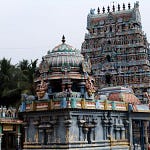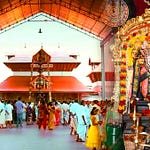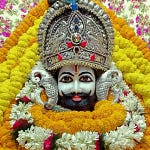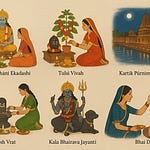In the western tip of India, where the Gomti River meets the Arabian Sea, lies the sacred city of Dwarka—a place that echoes with chants of "Jai Dwarkadhish!" and vibrates with the footsteps of countless pilgrims. At its heart stands the Dwarkadhish Temple, also known as Jagat Mandir, one of the most revered Vaishnavite shrines in India and an eternal symbol of Krishna Bhakti.
This article explores every layer of this divine destination—its origin, mythology, rituals, aarti, architecture, and travel guide—so that every seeker can walk the divine path with complete understanding.
📜 The Origin and Mythological Significance
🧿 Who is Dwarkadhish?
Dwarkadhish means “King of Dwarka”—a title given to Lord Krishna in his regal form after he migrated from Mathura to Dwarka to establish his kingdom and protect his people from continuous invasions.
🧚♂️ The Myth of Submerged Dwarka
As per Skanda Purana, Harivamsa, and Mahabharata, Lord Krishna built a golden city with 900 palaces and lush gardens on the coast of Gujarat. After his earthly departure, it is believed that Dwarka submerged into the sea—a phenomenon even supported by modern marine archaeological evidence showing submerged structures off the Dwarka coast.
🧒 Krishna’s Journey to Kingship
After slaying Kansa in Mathura, Krishna faced threats from Jarasandha and other enemies. To protect the Yadavas, he moved westward and built Dwarka—a fortified, planned city and administrative capital, transforming from Makhan Chor (butter thief) to Dwarkadhish (King of Dharma).
🕉️ Religious Essence and Spiritual Importance
Char Dham Pilgrimage: Dwarka is one of the four sacred sites in the Char Dham Yatra, established by Adi Shankaracharya.
Sapta Puri: It’s also among the seven holiest cities (Mokshapuris) of India.
Vaishnavite Devotion: The temple is a major center for Krishna worship, especially for the Pushtimarg and Vallabhacharya sects.
“Dwarkadhish is not merely a deity, but the divine king who governs dharma, protects the devotees, and blesses all seekers with wisdom and moksha.”
🛕 History & Architecture of the Temple
🏛️ Historical Timeline
Believed to be built by Vajranabh (Krishna’s great-grandson) around 2500 years ago
Current structure: Renovated in the 15th-16th century
Architectural Style: Māru-Gurjara style (Chaulukyan architecture)
🧱 Architectural Highlights
Height: Approx. 78.3 meters (256 feet)
Pillars: 72 intricately carved limestone pillars
Flag: A 52-yard silk flag with the Sun and Moon is changed five times daily
The main sanctum houses the black-marble idol of Lord Krishna in his majestic royal form, flanked by idols of Rukmini, Balaram, and other family members in nearby shrines.
🛐 Daily Puja, Aarti, and Rituals
🪔 Aarti Timings
Mangala Aarti – 6:30 AM
The first aarti of the day, performed to wake up the Lord and begin the day with auspicious energy.Shringar Aarti – 10:30 AM
Aarti during which the Lord is beautifully adorned with clothes, ornaments, and flowers.Rajbhog Aarti – 11:30 AM
A grand aarti that accompanies the offering of the main meal (bhog) to Lord Krishna.Utthapan Aarti – 5:30 PM
Aarti to awaken the Lord from his afternoon rest and begin the evening rituals.Sandhya Aarti – 7:30 PM
The evening aarti, offered with lamps and bhajans, signifying the Lord’s divine presence at dusk.Shayan Aarti – 8:30 PM to 9:00 PM
The final aarti of the day, where the Lord is offered rest and put to sleep for the night.
🧘 Special Rituals
Abhishek: Ritual bathing of the idol with water, milk, honey, and flowers
Tulsi and Chandan Seva: Offering holy basil and sandalwood paste
Annadan & Bhog: Pilgrims can contribute to food offerings and partake in prasad
🗓️ Major Festivals Celebrated
Janmashtami: Lord Krishna’s birthday, celebrated with midnight aarti and bhajans
Rath Yatra: Procession of Krishna's idol on a chariot
Diwali and Annakut: Offering hundreds of dishes to the Lord
Holi, Gopashtami, and Sharad Purnima are celebrated with grandeur
🧳 Travel Guide: How to Reach Dwarkadhish Temple
✈️ By Air:
Nearest Airport: Jamnagar (137 km away)
Daily flights from Delhi, Mumbai, and Ahmedabad
🚆 By Train:
Dwarka Railway Station: Well-connected to Mumbai, Delhi, Ahmedabad, and Rajkot
🚗 By Road:
Excellent roads from Ahmedabad (450 km), Rajkot (225 km), and Jamnagar
🗺️ Places to Visit Around Dwarka
🛕 Bet Dwarka (30 km via boat)
Krishna’s original residential palace with family
Believed to be where Krishna met Sudama
🛕 Rukmini Devi Temple (2 km)
Dedicated to Krishna’s consort, Rukmini
🛕 Nageshwar Jyotirlinga (17 km)
One of the 12 sacred Shiva Jyotirlingas
🛕 Gomti Ghat
Ritual bathing point, also visit Chakratirth where Sudarshan Chakra is believed to have fallen
🏨 Where to Stay
Luxury Options: Hawthorn Suites, Lords Eco Inn
Mid-Range: Hotel Meera, Hotel Krishna Inn
Budget & Dharmshalas: ISKCON Guesthouse, Gujarat State guest houses
🙏 Tips for Devotees
Wear traditional or modest clothing (saree, kurta-pajama)
Phones and leather items are not allowed inside temple premises
Visit early morning or during evening aarti for a divine experience
You can sponsor flags, aartis, bhog, or annadan seva
✨ Why Visit Dwarkadhish Temple?
Dwarkadhish Temple is not just a sacred structure—it is the embodiment of Krishna’s royal glory and divine love. It is a place where myth meets reality, and devotion meets architecture. Whether you are a spiritual seeker, a traveler, or a curious student of Indian heritage, Dwarka offers a mystical connection to a divine past that continues to live on.
“In Dwarka, the wind carries Krishna’s flute song, and the waves whisper his eternal name—Dwarkadhish.”










